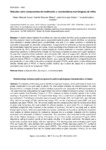Use este identificador para citar ou linkar para este item:
http://www.alice.cnptia.embrapa.br/alice/handle/doc/1010039| Título: | Relações entre componentes de rendimento e características morfológicas de milho. |
| Autoria: | SOUZA, T. V. de  RIBEIRO, C. M.   SCALON, J. D.   GUEDES, F. L.   |
| Afiliação: | Tadeu Vilela de Souza; Camila Marques Ribeiro; João Domingos Scalon; FERNANDO LISBOA GUEDES, CNPC. |
| Ano de publicação: | 2014 |
| Referência: | Magistra, Cruz das Almas, v. 26, n. 4, p. 495-506, out./dez. 2014. |
| Conteúdo: | Resumo: O objetivo desse trabalho foi identificar por meio da análise de trilha, quais caracteres da planta de milho possuem maior contribuição para a sua produtividade de grãos, visando identificar os caracteres mais indicados à seleção indireta para a produtividade, pois este é um caráter complexo e resultante da expressão e associação de diferentes componentes. O experimento foi conduzido na fazenda experimental da Universidade Federal de Lavras, em Lavras. Foram escolhidas cinco linhagens de milho do Programa de Melhoramento da UFLA, obtidas pela autofecundação de híbridos existentes no mercado, obtendo-se 15 tratamentos genéticos. O delineamento utilizado foi o de blocos completos ao acaso com quatro repetições. Os seguintes caracteres foram avaliados: altura de planta (AP), altura de espiga (AE), diâmetro do colmo (DC), peso de 100 grãos (P100), peso total de grãos (PT), número de grãos por planta (NGP) e produção de grãos por planta (PROD). A análise de trilha mostrou que o peso de 100 grãos foi o componente primário que apresentou o maior efeito direto sobre a produção de grãos (PROD), sendo assim, o mais indicado para seleção indireta para a PROD. A mesma análise mostrou que a altura de espiga foi o componente secundário mais influente na variação da PROD. [Relationships between yield components and morphological characteristics of maize]. Abstract: The objective of this study was to identify through path analysis, which plant traits of maize have greater contribution to the grain yield, to identify the most suitable character for indirect selection for yield, because this is a complex character and the resulting expression and association of different components. The experiment was conducted at the Experimental Farm of the Federal University of Lavras. Five strains of corn were selected from Breeding Program of UFLA, obtained by selfing of existing hybrids in the market, resulting in 15 genetic treatments. The experimental design was a randomized complete block design with four replications. The following characters were evaluated: plant height (AP), ear height (AE), stem diameter (DC), 100 kernels weight (P100), total kernels weight (PT), number of kernels per plant (NGP) and grain production per plant (PROD). The 100 kernels weight was the component that had the highest direct effect on grain yield, being thus, the most suitable for indirect selection for grain yield. The ear height was the secondary component most influential in the variation of Summary: The aim of this study was to identify through path analysis, which corn plant traits have greater contribution to its yield, to identify the characters more suitable to indirect selection for productivity, because this is a complex character and the resulting expression and association of different components. The experiment was conducted at the experimental farm of the Federal University of Lavras. Five strains of corn were chosen Improvement Program UFLA, obtained by selfing of existing hybrids on the market, resulting in 15 genetic treatments. The design was a randomized complete block design with four replications. The following traits were evaluated: plant height (PH), ear height (AE), stem diameter (DC), weight of 100 grains (P100), total grain weight (PT), number of grains per plant (NGP ) and grain yield per plant (PROD). Path analysis showed that the 100-grain weight was the primary component that had the highest direct effect on grain production (PROD), so the most suitable for indirect selection to PROD. The same analysis has shown that the ear height was the most influential on the variation of the secondary component PROD. PROD. |
| Thesagro: | Milho Zea mays Rendimento Melhoramento genético vegetal |
| NAL Thesaurus: | Yields |
| Palavras-chave: | Análise de trilha Multicolinearidade Path analysis Maize Multicollinearity |
| Tipo do material: | Artigo de periódico |
| Acesso: | openAccess |
| Aparece nas coleções: | Artigo em periódico indexado (CNPC)  |
Arquivos associados a este item:
| Arquivo | Descrição | Tamanho | Formato | |
|---|---|---|---|---|
| cnpc2014Relacoes.pdf | 188,32 kB | Adobe PDF |  Visualizar/Abrir |









